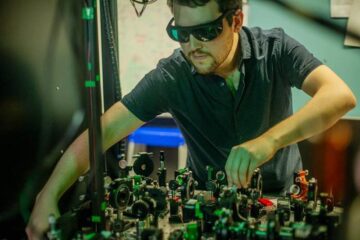Competing to use "green" words

The environmental movement is no longer the only ones concerned about the climate and the environment. An increasing number of companies now want to appear socially responsible, and have started using words which the environmental movement long considered their very own.
“It is, however, not correct to say that the companies have hi-jacked the green words from the environmental movement. It is rather a matter of businesses having incorporated the green words into their language, using them for their own purpose,” Mark Brown claims. He is a graduate engineer, Cand. philol. (MA) and associate professor at the Institute for Communication, Culture and Languages at BI Norwegian School of Management.
Analysed 9 million words
In connection with his doctorate project at the University of Oslo, Brown has examined how environmental organisations and companies are using green words. He has downloaded all the texts from homepages of 37 selected non-governmental environmental organisations and 25 green companies in the UK. The texts constitute a total of 9 million words, which are gathered in two databases, six million words from the environmental organisations and 3 million words from businesses.
Brown has then compared the language of the two databases with the British National Corpus, which is a standard for average English. He has concentrated on finding the special characteristics of the players' use of the language, and has identified key words. By means of a computer programme he has discovered patterns in the relationship between the words.
Three ways of looking at risk
The BI researcher has found patterns in the use of the language which demonstrate that the companies have adopted the environmental movement's terms. Green companies use the environmental movement's language in describing their own environmentally friendly ambitions, but they use the words in new ways to suit their own purpose.
“My linguistic analyses demonstrate clearly that green trade and industry use certain words in a totally different way than the environmental movement”, says Brown. He mentions the word “risk” as an example. In its language, the environmental movement represents the assumed source of the risk and the potential consequences to nature, but says little of how the risk can be managed or controlled.
Green businesses, in turn, focus mostly on managing, controlling and dealing with the risk, to make sure that the chances of this risk occurring are minimal – i.e. practically non-existent. Businesses say very little of the source of the risk, and very little about the consequences for the natural landscape should this risk become reality.
The companies hi-jack nature
Only to a very small degree does the language used by the green businesses contain words that we usually associate with nature – such as trees, flowers, lakes, etc. The companies use “executive language”, a management language which makes it possible to manage their relationship with the environment and natural landscape.
The environmentally friendly companies use green words which are tailored to their own businesses, such as “emissions per kilowatt-hour” and “bio-diversity indicator”. Using such measurable terms, the company means to control nature, offsetting the impact and harm to nature against their own production.
“The consequences of this trend ought to provoke some thoughts also in Norwegians”, says Brown. He believes he can document that the well-meaning answers from the businesses to the environmental movement in fact may contribute towards exterminating untouched nature.
“Norway is in the process of becoming a completely controlled landscape – a nature shaped by the green companies' technology, and it is all done in the name of sustainable development”, he warns.
Media Contact
More Information:
http://www.bi.noAll latest news from the category: Ecology, The Environment and Conservation
This complex theme deals primarily with interactions between organisms and the environmental factors that impact them, but to a greater extent between individual inanimate environmental factors.
innovations-report offers informative reports and articles on topics such as climate protection, landscape conservation, ecological systems, wildlife and nature parks and ecosystem efficiency and balance.
Newest articles

Combatting disruptive ‘noise’ in quantum communication
In a significant milestone for quantum communication technology, an experiment has demonstrated how networks can be leveraged to combat disruptive ‘noise’ in quantum communications. The international effort led by researchers…

Stretchable quantum dot display
Intrinsically stretchable quantum dot-based light-emitting diodes achieved record-breaking performance. A team of South Korean scientists led by Professor KIM Dae-Hyeong of the Center for Nanoparticle Research within the Institute for…

Internet can achieve quantum speed with light saved as sound
Researchers at the University of Copenhagen’s Niels Bohr Institute have developed a new way to create quantum memory: A small drum can store data sent with light in its sonic…





















